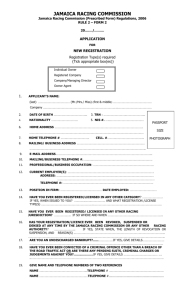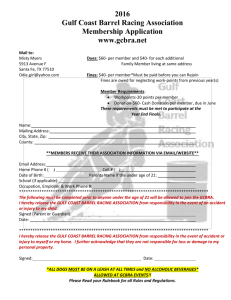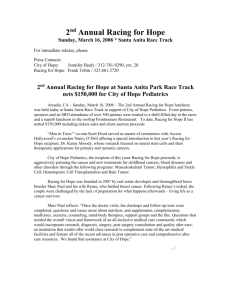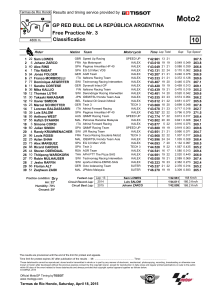12480030 C5R Blocks
advertisement
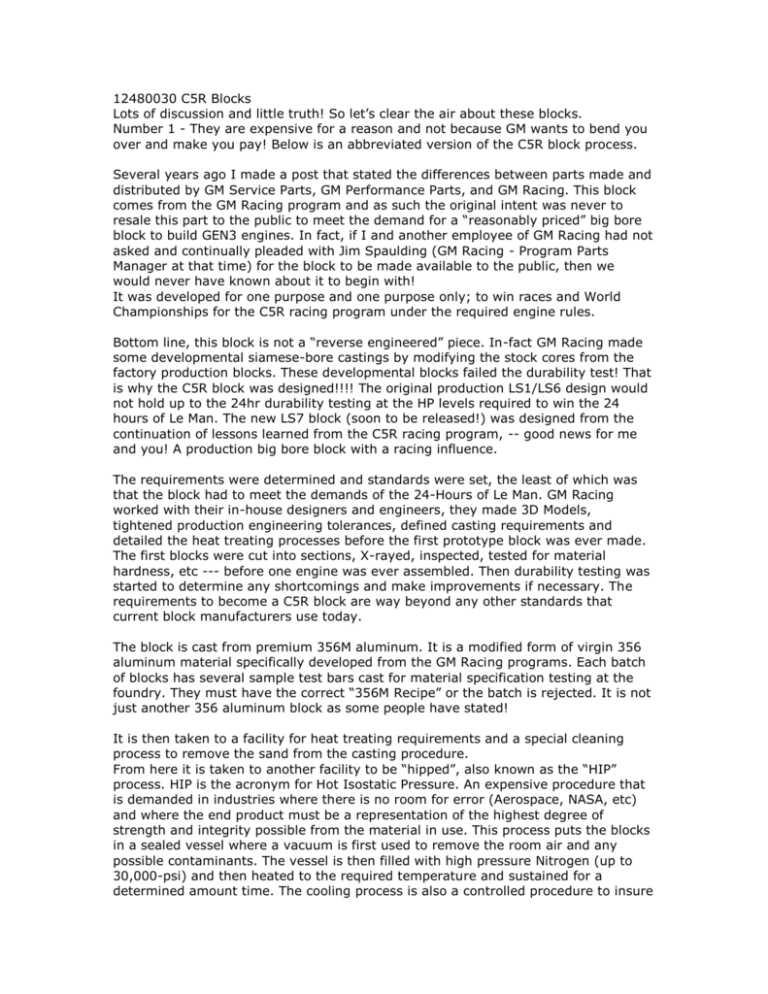
12480030 C5R Blocks Lots of discussion and little truth! So let’s clear the air about these blocks. Number 1 - They are expensive for a reason and not because GM wants to bend you over and make you pay! Below is an abbreviated version of the C5R block process. Several years ago I made a post that stated the differences between parts made and distributed by GM Service Parts, GM Performance Parts, and GM Racing. This block comes from the GM Racing program and as such the original intent was never to resale this part to the public to meet the demand for a “reasonably priced” big bore block to build GEN3 engines. In fact, if I and another employee of GM Racing had not asked and continually pleaded with Jim Spaulding (GM Racing - Program Parts Manager at that time) for the block to be made available to the public, then we would never have known about it to begin with! It was developed for one purpose and one purpose only; to win races and World Championships for the C5R racing program under the required engine rules. Bottom line, this block is not a “reverse engineered” piece. In-fact GM Racing made some developmental siamese-bore castings by modifying the stock cores from the factory production blocks. These developmental blocks failed the durability test! That is why the C5R block was designed!!!! The original production LS1/LS6 design would not hold up to the 24hr durability testing at the HP levels required to win the 24 hours of Le Man. The new LS7 block (soon to be released!) was designed from the continuation of lessons learned from the C5R racing program, -- good news for me and you! A production big bore block with a racing influence. The requirements were determined and standards were set, the least of which was that the block had to meet the demands of the 24-Hours of Le Man. GM Racing worked with their in-house designers and engineers, they made 3D Models, tightened production engineering tolerances, defined casting requirements and detailed the heat treating processes before the first prototype block was ever made. The first blocks were cut into sections, X-rayed, inspected, tested for material hardness, etc --- before one engine was ever assembled. Then durability testing was started to determine any shortcomings and make improvements if necessary. The requirements to become a C5R block are way beyond any other standards that current block manufacturers use today. The block is cast from premium 356M aluminum. It is a modified form of virgin 356 aluminum material specifically developed from the GM Racing programs. Each batch of blocks has several sample test bars cast for material specification testing at the foundry. They must have the correct “356M Recipe” or the batch is rejected. It is not just another 356 aluminum block as some people have stated! It is then taken to a facility for heat treating requirements and a special cleaning process to remove the sand from the casting procedure. From here it is taken to another facility to be “hipped”, also known as the “HIP” process. HIP is the acronym for Hot Isostatic Pressure. An expensive procedure that is demanded in industries where there is no room for error (Aerospace, NASA, etc) and where the end product must be a representation of the highest degree of strength and integrity possible from the material in use. This process puts the blocks in a sealed vessel where a vacuum is first used to remove the room air and any possible contaminants. The vessel is then filled with high pressure Nitrogen (up to 30,000-psi) and then heated to the required temperature and sustained for a determined amount time. The cooling process is also a controlled procedure to insure maximum strength and proper heat treat. This extreme high pressure and heat removes almost 100% of the internal porosities that are generated during the casting process. The hipping procedure will clearly show defects that might not have been caught until the block had been subjected to actual race applications under high stress and heat. The material integrity is greatly enhanced because of hipping and the material strength and fatigue life will increase significantly. Any block that exhibits an exterior surface hole after hipping is considered a defect. Most manufacturers will weld and re-sandblast any small defect or holes to cover up the imperfection. Not GM Racing! Actually, I do not know of any aluminum blocks made by other manufacturers that use the HIP process – it is too expensive and time consuming! Not to say that this does not exist, I am just not aware of any. The blocks that passed the hipping process are then taken for an X-ray to determine if there are any internal voids, cracks, imperfections or flaws that could lead to a block failure. 20% of the castings will have been eliminated by this time! Note; the hipping process is so extreme that most castings will exhibit some shrinkage from the high pressure. Therefore, one must take this into account during the initial design phase! Raw castings may need to be dimensionally increased from 1% to 2% if hipping is to be applied. The qualified blocks are now taken to a final heat treating process to arrive at the T6 designation. After the final heat treat, the blocks are blasted, cleaned, inspected, and packaged for shipment to the machining center. You now have a hipped and X-rayed 356M-T6 premium aluminum qualified casting. At the machining source, the casting is inspected and set-up on a qualifying fixture. The water jacket is probed to center the bores to eliminate any thin sections. GM Racing stipulates the requirement for a uniform bore wall thickness. If a block can not meet this requirement then you will not be able to buy it! The castings are qualified and the machining process starts. Keep in mind, the most critical tolerances are held to 0.0005”. The relative positions of the deck in relation to the cam, crank, and cylinder bores is held to a tolerance of 0.001”, therefore you receive a true blueprinted and “squared” block! For the layman, a typical sheet of paper is 0.003”. Try and slice it into 3-pcs if you can? Each block is 100% inspected throughout the machining process and fully 100% CMM(Coordinate Measuring Machine) measured on every dimension. In addition, the machinists are required to check all dimensional tolerances during the process and document all numbers. All the data is on file for GM Engineers to review at anytime!!!! Special liners are made from a material that GM Racing has developed from its NASCAR & Indy Racing programs. This is not just another cast iron liner as some people have stated! The liners are installed with a special process developed in racing programs and then machined to size for a true and straight bore. Some of the other aftermarket aluminum block manufacturers install liners that are premachined. The block includes premium head studs made from 4340 material with rolled threads - not cut. The blocks come with special screw-in AN-style water jacket plugs with o-ring seals in all locations including the oil galleries. Also included is a tube of special lube for assembly which GM Racing tested against all the other lubes and oils on the market for accurate and repeatable torque readings. Main caps are made from premium 8620 material. The caps are coated with black oxide and laser etched with the GM Racing logo and part number. The blocks are leak tested and packaged for shipment in special high quality wooden boxes so the block is not damaged. Each serial numbered block contains a documented sheet showing the critical dimensions for that block. Have you ever seen the boxes the C5R blocks come in? They are made from 5-layer Birch plywood! You can make cabinets for your house with this plywood! I do not why they did this! It is certainly overkill, but at least the block is protected. When you open the box and look at the GM Racing C5R block, you know it is a premium part. Look at the micro finish on the machined surfaces. The machined finish is like a mirror. Compare that and the other features described here with other manufacturers and not just the price. GM Racing has invested the time and money to make sure this block will meet the requirements it was intended to fulfill, which should far exceed most any application that you and I will ever try to use this block for. And people want to claim that a machined LS1/LS6 block with the Darton sleeve system has the same structural integrity and capabilities as the C5R block??? Sorry, I beg to differ. The LS1/LS6 block was already lacking before you cut it up. The Darton sleeve system is not going to make up for the differences in block material, heat treating, hipping, main web strengthening and other features that GM Racing designed into the block. Could GM have produced a cheaper block that would have met our needs? Sure! But they didn’t because that was not the intent of the C5R block. As most always is the case, you get what you pay for! Now we all know what we are paying for! Not to say that the LS1/LS6 Darton MID blocks do not fit a need, they do! And they are appropriately priced for what you get, but it is not the same as a C5R block by any means. Do I want cheaper big bore blocks that will meet high HP needs? Absolutley! In closing – big bore blocks are coming! And they are not Darton sleeved LS1/LS6 blocks. The LS7 will be here before the years end and I have already seen a big bore block from another manufacturer (not Dart and not World!). Both will be priced appropriately! Things will change and products will improve! They say in the fashion business that things are on a 25 to 30-year cycle. Seems to be true for the Small Block Chevrolet also! The future holds some big horsepower for gearheads like me and it will be affordable! Nicky Fowler GM Performance Guru & Chief Gearhead @ SDPC __________________ Technical Info From Scoggin Dickey Parts Center

